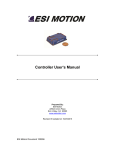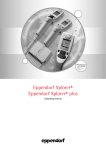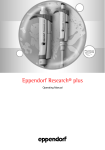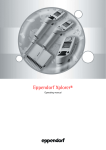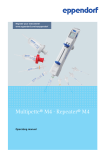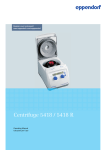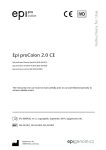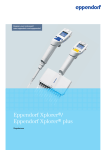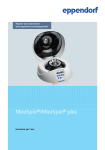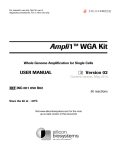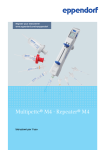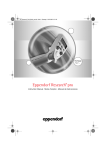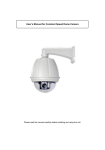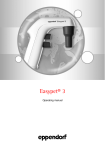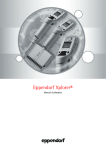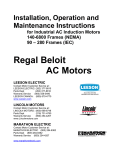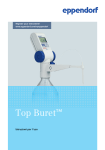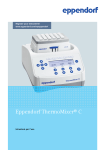Download Eppendorf Reference® 2
Transcript
eference® nual 2 g EN) manual Register your instrument! www.eppendorf.com/myeppendorf Eppendorf Reference® 2 Operating manual Copyright© 2013 Eppendorf AG, Hamburg. No part of this publication may be reproduced without the prior permission of the copyright owner. Trademarks Eppendorf® and the Eppendorf logo are registered trademarks of Eppendorf AG, Hamburg, Germany. Combitips®, epT.I.P.S.®, and Reference® 2 are registered trademarks of Eppendorf AG, Hamburg, Germany. Registered trademarks are not marked in all cases with ™ or ® in this manual. Further information can be found on the enclosed CD. 4920 900.017-01/052013 Table of contents Eppendorf Reference® 2 English (EN) Table of contents 1 Operating instructions . . . . . . . . . . . . . . . . . . . . . . . . . . . . . . . . . . . . . . . . . . . . . . . . . . . . . . . . . . . . . . 5 1.1 Using this manual . . . . . . . . . . . . . . . . . . . . . . . . . . . . . . . . . . . . . . . . . . . . . . . . . . . . . . . . . . . . . 5 1.2 Danger symbols and danger levels . . . . . . . . . . . . . . . . . . . . . . . . . . . . . . . . . . . . . . . . . . . . . . . . 5 1.2.1 Danger symbols. . . . . . . . . . . . . . . . . . . . . . . . . . . . . . . . . . . . . . . . . . . . . . . . . . . . . . . . 5 1.2.2 Danger levels. . . . . . . . . . . . . . . . . . . . . . . . . . . . . . . . . . . . . . . . . . . . . . . . . . . . . . . . . . 5 1.3 Symbols used . . . . . . . . . . . . . . . . . . . . . . . . . . . . . . . . . . . . . . . . . . . . . . . . . . . . . . . . . . . . . . . . 5 2 Product description . . . . . . . . . . . . . . . . . . . . . . . . . . . . . . . . . . . . . . . . . . . . . . . . . . . . . . . . . . . . . . . . 7 2.1 Features. . . . . . . . . . . . . . . . . . . . . . . . . . . . . . . . . . . . . . . . . . . . . . . . . . . . . . . . . . . . . . . . . . . . . 7 2.1.1 Pipette models. . . . . . . . . . . . . . . . . . . . . . . . . . . . . . . . . . . . . . . . . . . . . . . . . . . . . . . . . 7 2.2 Delivery package . . . . . . . . . . . . . . . . . . . . . . . . . . . . . . . . . . . . . . . . . . . . . . . . . . . . . . . . . . . . . . 8 2.3 Main illustration . . . . . . . . . . . . . . . . . . . . . . . . . . . . . . . . . . . . . . . . . . . . . . . . . . . . . . . . . . . . . . 9 2.3.1 Reference 2 single-channel. . . . . . . . . . . . . . . . . . . . . . . . . . . . . . . . . . . . . . . . . . . . . . . 9 2.3.2 Reference 2 Multi-channel . . . . . . . . . . . . . . . . . . . . . . . . . . . . . . . . . . . . . . . . . . . . . . 10 2.4 Materials . . . . . . . . . . . . . . . . . . . . . . . . . . . . . . . . . . . . . . . . . . . . . . . . . . . . . . . . . . . . . . . . . . . 11 2.5 Storing the pipette . . . . . . . . . . . . . . . . . . . . . . . . . . . . . . . . . . . . . . . . . . . . . . . . . . . . . . . . . . . 12 2.5.1 Pipette carousel. . . . . . . . . . . . . . . . . . . . . . . . . . . . . . . . . . . . . . . . . . . . . . . . . . . . . . . 12 2.5.2 Holder . . . . . . . . . . . . . . . . . . . . . . . . . . . . . . . . . . . . . . . . . . . . . . . . . . . . . . . . . . . . . . 12 2.5.3 Wall mount . . . . . . . . . . . . . . . . . . . . . . . . . . . . . . . . . . . . . . . . . . . . . . . . . . . . . . . . . . 12 3 Safety. . . . . . . . . . . . . . . . . . . . . . . . . . . . . . . . . . . . . . . . . . . . . . . . . . . . . . . . . . . . . . . . . . . . . . . . . . . 13 3.1 Intended use . . . . . . . . . . . . . . . . . . . . . . . . . . . . . . . . . . . . . . . . . . . . . . . . . . . . . . . . . . . . . . . . 13 3.2 Warnings for intended use . . . . . . . . . . . . . . . . . . . . . . . . . . . . . . . . . . . . . . . . . . . . . . . . . . . . . 13 4 Operation. . . . . . . . . . . . . . . . . . . . . . . . . . . . . . . . . . . . . . . . . . . . . . . . . . . . . . . . . . . . . . . . . . . . . . . . 15 4.1 Setting the volume (only Reference 2 variable) . . . . . . . . . . . . . . . . . . . . . . . . . . . . . . . . . . . . . 15 4.2 Using pipette tips . . . . . . . . . . . . . . . . . . . . . . . . . . . . . . . . . . . . . . . . . . . . . . . . . . . . . . . . . . . . 15 4.3 Deactivating the tip cone spring loading . . . . . . . . . . . . . . . . . . . . . . . . . . . . . . . . . . . . . . . . . . 16 4.4 Aspirating liquid . . . . . . . . . . . . . . . . . . . . . . . . . . . . . . . . . . . . . . . . . . . . . . . . . . . . . . . . . . . . . 16 4.5 Dispensing liquid . . . . . . . . . . . . . . . . . . . . . . . . . . . . . . . . . . . . . . . . . . . . . . . . . . . . . . . . . . . . 16 5 Troubleshooting . . . . . . . . . . . . . . . . . . . . . . . . . . . . . . . . . . . . . . . . . . . . . . . . . . . . . . . . . . . . . . . . . . 17 5.1 Error search. . . . . . . . . . . . . . . . . . . . . . . . . . . . . . . . . . . . . . . . . . . . . . . . . . . . . . . . . . . . . . . . . 17 6 Maintenance . . . . . . . . . . . . . . . . . . . . . . . . . . . . . . . . . . . . . . . . . . . . . . . . . . . . . . . . . . . . . . . . . . . . . 19 6.1 Cleaning . . . . . . . . . . . . . . . . . . . . . . . . . . . . . . . . . . . . . . . . . . . . . . . . . . . . . . . . . . . . . . . . . . . 19 6.2 Sterilizing or disinfecting the pipette . . . . . . . . . . . . . . . . . . . . . . . . . . . . . . . . . . . . . . . . . . . . . 20 6.2.1 Autoclaving . . . . . . . . . . . . . . . . . . . . . . . . . . . . . . . . . . . . . . . . . . . . . . . . . . . . . . . . . . 20 6.2.2 Disinfection . . . . . . . . . . . . . . . . . . . . . . . . . . . . . . . . . . . . . . . . . . . . . . . . . . . . . . . . . . 21 6.3 Replacing O-rings . . . . . . . . . . . . . . . . . . . . . . . . . . . . . . . . . . . . . . . . . . . . . . . . . . . . . . . . . . . . 21 6.3.1 Removing the O-ring . . . . . . . . . . . . . . . . . . . . . . . . . . . . . . . . . . . . . . . . . . . . . . . . . . . 21 6.3.2 Mounting a new O-ring . . . . . . . . . . . . . . . . . . . . . . . . . . . . . . . . . . . . . . . . . . . . . . . . . 21 6.4 Disassembling and assembling the pipette lower part . . . . . . . . . . . . . . . . . . . . . . . . . . . . . . . . 22 6.4.1 Single-channel lower part up to 1000 μL . . . . . . . . . . . . . . . . . . . . . . . . . . . . . . . . . . . 22 6.4.2 Single-channel lower part . . . . . . . . . . . . . . . . . . . . . . . . . . . . . . . . . . . . . . . . . . . . . . . 24 6.4.3 Multi-channel lower part. . . . . . . . . . . . . . . . . . . . . . . . . . . . . . . . . . . . . . . . . . . . . . . . 26 3 4 Table of contents Eppendorf Reference® 2 English (EN) 6.5 6.6 Adjusting pipettes . . . . . . . . . . . . . . . . . . . . . . . . . . . . . . . . . . . . . . . . . . . . . . . . . . . . . . . . . . . . 28 6.5.1 General instructions on user and factory adjustment . . . . . . . . . . . . . . . . . . . . . . . . . . 28 6.5.2 Changing the user adjustment . . . . . . . . . . . . . . . . . . . . . . . . . . . . . . . . . . . . . . . . . . . 30 6.5.3 Changing the factory adjustment . . . . . . . . . . . . . . . . . . . . . . . . . . . . . . . . . . . . . . . . . 31 Decontamination before shipment . . . . . . . . . . . . . . . . . . . . . . . . . . . . . . . . . . . . . . . . . . . . . . . 32 7 Technical data . . . . . . . . . . . . . . . . . . . . . . . . . . . . . . . . . . . . . . . . . . . . . . . . . . . . . . . . . . . . . . . . . . . . 33 7.1 Reference 2 Single-channel variable. . . . . . . . . . . . . . . . . . . . . . . . . . . . . . . . . . . . . . . . . . . . . . 33 7.2 Reference 2 Multi-channel variable . . . . . . . . . . . . . . . . . . . . . . . . . . . . . . . . . . . . . . . . . . . . . . 34 7.3 Reference 2 fixed . . . . . . . . . . . . . . . . . . . . . . . . . . . . . . . . . . . . . . . . . . . . . . . . . . . . . . . . . . . . 35 7.4 Test conditions . . . . . . . . . . . . . . . . . . . . . . . . . . . . . . . . . . . . . . . . . . . . . . . . . . . . . . . . . . . . . . 36 7.5 Ambient conditions . . . . . . . . . . . . . . . . . . . . . . . . . . . . . . . . . . . . . . . . . . . . . . . . . . . . . . . . . . . 36 8 Ordering Information . . . . . . . . . . . . . . . . . . . . . . . . . . . . . . . . . . . . . . . . . . . . . . . . . . . . . . . . . . . . . . 37 8.1 Single-channel pipettes, variable volume . . . . . . . . . . . . . . . . . . . . . . . . . . . . . . . . . . . . . . . . . . 37 8.2 Single-channel pipettes, fixed volume . . . . . . . . . . . . . . . . . . . . . . . . . . . . . . . . . . . . . . . . . . . . 37 8.3 Single-channel lower part for variable volume and fixed volume . . . . . . . . . . . . . . . . . . . . . . . 38 8.4 Multi-channel pipettes . . . . . . . . . . . . . . . . . . . . . . . . . . . . . . . . . . . . . . . . . . . . . . . . . . . . . . . . 38 8.5 Multi-channel lower parts . . . . . . . . . . . . . . . . . . . . . . . . . . . . . . . . . . . . . . . . . . . . . . . . . . . . . . 39 8.5.1 8-channel lower parts . . . . . . . . . . . . . . . . . . . . . . . . . . . . . . . . . . . . . . . . . . . . . . . . . . 39 8.5.2 12-channel lower parts . . . . . . . . . . . . . . . . . . . . . . . . . . . . . . . . . . . . . . . . . . . . . . . . . 39 8.6 Spare parts, accessories and pipette tips . . . . . . . . . . . . . . . . . . . . . . . . . . . . . . . . . . . . . . . . . . 39 9 Patents. . . . . . . . . . . . . . . . . . . . . . . . . . . . . . . . . . . . . . . . . . . . . . . . . . . . . . . . . . . . . . . . . . . . . . . . . . 41 Index . . . . . . . . . . . . . . . . . . . . . . . . . . . . . . . . . . . . . . . . . . . . . . . . . . . . . . . . . . . . . . . . . . . . . . . . . . . 42 Operating instructions Eppendorf Reference® 2 English (EN) 1 1.1 Operating instructions Using this manual Read this operating manual completely before using the device for the first time. Please also note the operating instructions for the accessories, if applicable. This operating manual is part of the product. Thus, it must always be easily accessible. Enclose this operating manual when transferring the device to third parties. 1.2 Danger symbols and danger levels The safety instructions in this manual appear with the following danger symbols and danger levels: 1.2.1 Danger symbols 1.2.2 Danger levels DANGER Will lead to severe injuries or death. WARNING May lead to severe injuries or death. CAUTION May lead to light to moderate injuries. NOTICE May lead to material damage. 1.3 Symbols used Representation Meaning Handling 1. 2. Actions in the specified order • List Direction of movement Text Name of fields in the software Useful information 5 6 Operating instructions Eppendorf Reference® 2 English (EN) Product description Eppendorf Reference® 2 English (EN) 2 2.1 Product description Features Reference 2 pipettes are piston-stroke pipettes which operate according to the air-cushion principle. For air cushion pipettes, a suitable pipette tip must be fitted prior to use. The user controls the dispensing, volume setting and ejector using the control button. When the control button is pressed, the piston in the pipette moves in the same direction. If the control button and the piston are moved upward, the liquid can be aspirated into the pipette tip. When the piston is moved downward, the liquid is dispensed (measuring stroke). Blow-out occurs if the control button is pressed down past the first stop. If the control button is pressed down again, the pipette tip will be ejected. The tip cone will spring load when a pipette tip is attached (exceptions: 2 mL to 10 mL pipettes). The Reference 2 pipettes can be adjusted. A viewing window below the adjustment seal indicates that a user adjustment has been modified. The user adjustment functions independent of the factory adjustment. All Reference 2 pipettes are fully autoclavable. 2.1.1 Pipette models The Reference 2 family consists of single-channel and multi-channel pipettes (8 and 12-channels) with variable volume settings, and single-channel fixed-volume pipettes. For Reference 2 pipettes with variable volume settings, the volume can be changed by turning the control button when the volume locking button is pressed. Volumes from 0.1 μL to 10 mL can be dispensed depending on the model. A list of all available models is available in the Technical Data. 7 8 Product description Eppendorf Reference® 2 English (EN) 2.2 Delivery package The following accessories are included in the delivery package: Piece Description 1 Operating manual 1 Certificate 1 Allen key with a blue handle (adjustment tool) 1 CD with information on chemical resistance, user adjustment, factory adjustment and ordering information 1 Black locking ring for single-channel pipettes ≤ 1000 μL 5 Red plastic adjustment seal (ADJ) 5 Protection filter consisting of 1 filter sleeve and 10 filter cartridges (for 2 mL to 10 mL pipettes) 1 Pipette wrench for opening the lower part (2 mL to 10 mL) 1 Multi-channel tool for cutting the O-rings (only 100 μL and 300 μL multi-channel lower parts) 5 Red plastic safety plug 1 Pin Product description Eppendorf Reference® 2 English (EN) 2.3 Main illustration 2.3.1 Reference 2 single-channel 1 2 3 Reference 2 4 J AD 5 6 1 Volume display Volume display with four-digit counter for variable pipettes. Decimal places are marked by a hyphen. 2 Color code The color code on the control button and the trays of the matching epT.I.P.S. pipette tips are in the same color. 3 Control button Sets and dispenses the volume, and ejects the pipette tip. 4 Volume locking button Locks the control button volume setting ring. Press a volume locking button at the left or right to set the volume. 5 User adjustment Upon delivery, the opening is sealed using a gray plastic adjustment seal (ADJ). 0000 000 7 8 6 User adjustment display Set to "0" before delivery. 7 Serial number Serial number for upper and lower parts. 8 Nominal volume 9 10 11 9 Ejector sleeve Ejects the pipette tip. Press the control button down all the way. 10 Spring-loaded tip cone The spring-loading action optimizes the force required to attach and eject tips (no spring-loaded action for 2 mL to 10 mL). For 2 mL to 10 mL pipettes, an exchangeable protection filter in a sleeve is located in the tip cone. 11 Pipette tip We recommend using epT.I.P.S. 9 Product description Eppendorf Reference® 2 English (EN) 2.3.2 Reference 2 Multi-channel For an explanation of the upper part of the pipette, refer to the main illustration of the single-channel pipette. 1 Lever Loosens the multi-channel lower part. 2 Housing lid Removable housing lid with retracted ejector rail. Reference 2 10 AD 0000 3 Multi-channel lower part The multi-channel lower part is freely rotatable. The lower part does not detach when it is rotated. The outer channels are labeled with the numbers 1 and 8 (or 12). The multi-channel version has a piston for each channel to ensure that a smaller number of pipette tips can also be mounted. The lower part can be converted from an 8 to a 12-channel version with the same volume range. The multi-channel lower part can be opened, enabling you to replace or remove individual channels. J 000 1 2 4 Latches One right latch and one left latch to unlock the housing lid. 3 5 Selection dial On/Off Switches on or off the spring loading of the tip cones. 4 5 6 7 6 Tip cones Spring-loaded tip cones optimize the force required to attach and eject pipette tips. 7 Pipette tips We recommend using epT.I.P.S. Product description Eppendorf Reference® 2 English (EN) 2.4 Materials NOTICE! Aggressive substances may damage the Reference 2 and accessories. Check the chemical resistance before using organic solvents or aggressive chemicals. Please note the cleaning instructions. Your can find further information on chemical resistance on the included CD or on our webpage www.eppendorf.com. The Reference 2 components that can be accessed by the user are made of the following materials: Component External surfaces of the upper part Material • Improved polypropylene (PP) • Polycarbonate (PC) • Polyetherimide (PEI) • Stainless steel Exterior and interior of lower parts • Improved polypropylene (PP) • Polyvinylidene fluoride (PVDF) • Polyetherimide (PEI) • Polyphenylene sulfide (PPS) • Polyetheretherketone (PEEK) • Polytetrafluoroethylene (PTFE) • Ethylene propylene diene rubber (EPDM) • Silicone • Steel (stainless steel and spring steel) Pipette tip Material epT.I.P.S. Polypropylene (PP) epDualfilter T.I.P.S. filter Polyethylene (PE) 11 12 Product description Eppendorf Reference® 2 English (EN) 2.5 Storing the pipette The pipette can be safely stored in a pipette carousel or a wall mounting device. 2.5.1 Pipette carousel A pipette carousel (4923) is available for storing Reference 2 pipettes. The pipette carousel features 6 holders that are designed for the Reference 2. Each holder features an image of a Reference 2 pipette to ensure that the pipettes are placed in the correct holder. 2.5.2 Holder The holder can also be installed in the pipette carousel (3115) for Research plus pipettes. 2.5.3 Wall mount An adhesive strip is used to prepare the wall mount for assembly on a level surface (glass, tile). Safety Eppendorf Reference® 2 English (EN) 3 3.1 Safety Intended use The intended use is described in a separate document enclosed in the package. 3.2 Warnings for intended use WARNING! Damages to health due to infectious liquids and pathogenic germs. When handling infectious liquids and pathogenic germs, observe the national regulations, the biological security level of your laboratory, the material safety data sheets, and the manufacturer's application notes. Wear personal protective equipment. Consult the "Laboratory Biosafety Manual" (Source: World Health Organization, Laboratory Biosafety Manual, as amended) for comprehensive regulations on the handling of risk group II germs or biological materials. WARNING! Damage to health due to toxic, radioactive or aggressive chemicals. Wear personal protective equipment. Observe the national regulations for handling these substances. Observe the material safety data sheets and manufacturer's application notes. CAUTION! Danger to individuals due to careless use. Never point the opening of a Reference 2 which is equipped with a pipette tip at yourself or other persons. Only initiate dispensing if it is safe to do so. With any dispensing task please ensure that you do not endanger yourself and other persons. CAUTION! Poor safety due to incorrect accessories and spare parts. The use of accessories and spare parts other than those recommended by Eppendorf may impair the safety, functioning and precision of the device. Eppendorf cannot be held liable or accept any liability for damage resulting from the use of incorrect or non-recommended accessories and spare parts, or from the improper use of such equipment. Only use accessories and original spare parts recommended by Eppendorf. 13 14 Safety Eppendorf Reference® 2 English (EN) NOTICE! Damage to device from missing pipette tips. Use the Reference 2 with fitted pipette tips only. When using pipette tips without filters, use 2-10 mL pipettes with protective sleeves and an inserted protection filter. NOTICE! Carry-over, contamination and incorrect dispensing results due to the incorrect use of pipette tips. The pipette tips are for single use only. Prolonged use can have a negative impact on dispensing tasks. Only use the pipette tips once. Do not use autoclaved ep Dualfilter T.I.P.S. for dispensing. NOTICE! Incorrect dispensing volume due to differences in temperature and for special liquids. Temperature differences between the pipette, pipette tips and liquid; or solutions with physical data that is very different from that of water; may result in incorrect dispensing volumes. Avoid temperature differences the between pipette, pipette tip and liquid. Ensure that the temperature is between 20 °C and 27 °C and remains constant at ±0.5 °C. Check the dispensing volume and make sure that you can affirm all the questions listed in the general information. NOTICE! Damage to the device due to penetration of liquids. Do not put the pipette down when the pipette tip is filled. Do not allow any liquids to penetrate the inside of the housing. If liquid has entered the inside of the housing, the inner parts may only be repaired by Eppendorf AG service partners. Contact your local sales office before returning any devices. Operation Eppendorf Reference® 2 English (EN) 4 4.1 Operation Setting the volume (only Reference 2 variable) To set the volume, hold the volume locking button pressed down - 4.2 0 0 0 0 10-100 µL and turn the control button. We recommend adjusting the volume setting from a higher value to a lower value. If required, turn beyond the required value and then back again. The height of the control button changes as the volume is adjusted. The volume is displayed up to 1000 μL in μL. For 2 mL to 10 mL pipettes, the volume is displayed in mL. Using pipette tips The liquid to be dispensed is aspirated into pipette tips. We recommend using epT.I.P.S. epT.I.P.S. pipette tips, which are available with various degrees of purity, with and without filters and as special tips. We recommend using special epT.I.P.S. LoRetention tips with liquids that have a lower surface tension than water (e.g., due to a wetting agent in the liquid). Pipette tips are for single use only. The pipette is only functional if a pipette tip has been attached. You can either attach the pipette tip by hand or directly insert the end of the pipette into a tip held in the tip storage box. If attaching a pipette tip by hand, it must be handled in a way that prevents contamination and heating of the pipette tip. The color code on the Reference 2 control button matches the color of the epT.I.P.S. trays If you use pipette tips without filter, insert the protection filter in the 2 mL to 10 mL pipette. Fit the suitable pipette tip(s) on the tip cone, applying light pressure. The pipette tip sits firmly on the tip cone when it spring loads (exceptions: no spring loading for 2 mL to 10 mL single-channel pipettes.) 15 16 Operation Eppendorf Reference® 2 English (EN) 4.3 Deactivating the tip cone spring loading For the following dispensing tasks, it may be helpful to deactivate the spring loading action of the tip cone. • A pipette tip is to be used over a long period of time. • The pipette tip is slightly bent during dispensing. • For pipette tips that are not designed for the tip cone of Eppendorf pipettes. The spring loading action of the tip cone on single-channel pipettes can be blocked by installing a locking ring. On multi-channel pipettes, the spring loading action of the tip cone can be switched on or off using the selection switch. 4.4 Aspirating liquid 1. The liquid to be aspirated must be taken from a suitable vessel. For multi-channel pipettes, we recommend the reagent reservoir "Tip-Tub". 2. Press down the control button to the first stop (measuring stroke). 3. Immerse the pipette tip(s) vertically approx. 4 mm into the liquid. 4. To aspirate liquid, allow the control button to slide back slowly. Maintain the immersion depth to ensure no air is aspirated. 5. In the case of large volumes: before removing the pipette tip from the liquid, wait for approx. 3 seconds. To ensure maximum precision and accuracy, we recommend to wet each new tip initially by aspirating and dispensing the liquid one to three times. Only then should pipetting commence. 6. Remove the tip(s) slowly from the liquid. 7. Wipe the tip(s) slowly against the tube wall to ensure that no outer wetting remains on the tip. 4.5 Dispensing liquid 1. Place the tip on the tube inner wall at an angle. 2. Press the control button slowly until the first stop (measuring stroke) and wait until the flow of liquid stops. 3. To empty the tip, press the control button until the second stop (blow-out). 4. Hold down the control button and wipe the tip on the tube inner wall. 5. To eject the tips, hold the control button all the way down. Troubleshooting Eppendorf Reference® 2 English (EN) 5 5.1 Troubleshooting Error search Symptom/message Cause Remedy Liquid is dripping The tip is loose or the pipette tip is poorly Firmly attach the pipette tips. Use from the tip and/or fitted. epT.I.P.S. pipette tips. the dispensed volume is incorrect. Liquid with high vapor pressure and/or different density. Wet the tip several times and adjust Pipetting was too quick. Move the control button slowly. The tip is withdrawn from the liquid too quickly. Withdraw the tip slowly from the Liquid aspirated with blow-out and dispensed with blow-out. Repeat dispensing correctly. Piston dirty or damaged. Clean piston, grease slightly and/or the pipette for the liquid used. liquid with a time delay (approx. 3 seconds). replace. The control button jams and does not move smoothly. The tip cone is damaged. Replace the lower part or channel. The O-rings of the tip cones are damaged. Replace the O-rings (only 100 μL, • The piston is dirty. • The seal is dirty. • Seal defective. 300 μL multi-channel). Clean the lower part. Replace the protection filter on 2 mL to 10 mL models. • The pipette is blocked. The adjustment seal has been removed; the adjustment display has been changed. The pipette has been adjusted for a different liquid. Adjust the pipette for the liquid used. No spring-loading action of the tip cone when pipette tips are inserted. Spring-loading action is blocked by a locking ring. Spring loading is switched off (multi-channel). Remove the locking ring again. Switch on spring loading. Use of a 2 mL to 10 mL pipette. No remedy available. The tip cone of these sizes does not have spring-loading action. 17 18 Troubleshooting Eppendorf Reference® 2 English (EN) Regularly check the precision and accuracy of the Reference 2 to prevent dispensing errors. You can use the "PICASO" software to determine the maximum permissible systematic and random errors. If the pipette is used at an extremely high altitude, it must be adjusted to the ambient air pressure. A Standard Operating Procedure (SOP) for checking pipettes can be found on the Reference 2 CD and on our webpage www.eppendorf.com. Maintenance Eppendorf Reference® 2 English (EN) 6 Maintenance NOTICE! Aggressive substances may damage the Reference 2 and accessories. Check the chemical resistance before using organic solvents or aggressive chemicals. Please note the cleaning instructions. Your can find further information on chemical resistance on the included CD or on our webpage www.eppendorf.com. • All single and multi-channel lower parts are wear parts. Clean them after contamination, use of aggressive chemicals and/or heavy stress. If the lower parts are worn or damaged, replace these parts. • Faulty dispensing results are sometimes due to lack of maintenance. 6.1 Cleaning NOTICE! Damage to device from unsuitable cleaning fluids or sharp or pointed objects. Unsuitable cleaning fluids can damage the device. Never use corrosive cleaning fluids, strong solvents or abrasive polishes. Check the compatibility with the materials used. Please note the information on chemical resistance (see CD). Do not clean the Reference 2 with acetone or organic solvents with a similar effect. Do not clean the Reference 2 with sharp objects. Remove external contamination on the Reference 2 as follows: Wet a cloth with a mild cleaning fluid and water and remove the contamination. To remove heavy contamination resulting from liquid penetration, disassemble the lower part of the pipette and clean it with demineralized water. Relubricate the piston sealing rings after contamination, use of aggressive chemicals and/or heavy stress. Remove the old grease before relubricating. Only use the grease specified in the ordering information (see the enclosed CD). 19 20 Maintenance Eppendorf Reference® 2 English (EN) 6.2 Sterilizing or disinfecting the pipette NOTICE! Damage to device from incorrect handling. Do not use any additional disinfectants, decontamination agents or sodium hypochlorite during autoclaving or UV exposure. When autoclaving, please ensure that the temperature does not exceed 121°C. Before using disinfecting agents or decontaminating agents, test for material compatibility and check the manufacturer's instructions on chemical resistance. Please also note the pipette material. 6.2.1 Autoclaving All Reference 2 pipettes are completely steam autoclavable. 6.2.1.1 Before autoclaving Remove any contamination from the exterior and the lower part. If you remove existing grease, slightly re-lubricate the piston seal using only the grease specified in the ordering information (see the enclosed CD). 6.2.1.2 Procedure Prerequisites • Follow the operating manual of the autoclave manufacturer. • Autoclave at: 121 °C, 20 minutes, 1 bar overpressure. 1. When placing the Reference 2 into the autoclave, make sure that the temperature at the pipette does not exceed 121 °C. 2. You can put the Reference 2 into the autoclave as a complete unit or with the lower part removed. Do not disassemble the lower part. 3. For 2 mL to 10 mL pipettes: remove old protection filter. Add a filter sleeve and new protection filter and insert them after autoclaving. Only autoclave the protection filter once. 4. If lower parts have been removed, make sure that no lower parts are confused during reassembly. (Tip: use one plastic beaker per pipette.) 6.2.1.3 After autoclaving Cool the pipette to room temperature and let it dry. For 2 mL to 10 mL pipettes: press the protection filter into the filter sleeve and insert it into the tip cone. The piston does not need to be relubricated after autoclaving. If autoclaving is carried out as described above, no gravimetric testing or adjustment is necessary. Maintenance Eppendorf Reference® 2 English (EN) 6.2.2 Disinfection Carefully wipe off the outer surfaces with disinfectant, DNA/RNA decontamination agents or 70 % isopropanol. You can wipe the outside of the tip cone and the ejector sleeve using a sodium hypochlorite solution of 4 %. After the exposure time of the sodium hypochlorite solution (15 minutes) has elapsed, thoroughly remove it using demineralized water. The Reference 2 pipettes may be temporarily subjected to the UV light of a sterile bench (≥ 254 nm). 6.3 Replacing O-rings The 100 μL and 300 μL multi-channel lower parts are equipped with O-rings. These are wear parts. Replace old, worn or damaged O-rings. Defective O-rings result in the incorrect positioning of the tips and in dispensing errors. 6.3.1 Removing the O-ring 1. Switch off the spring loading. 2. Push the opening of the O-ring tool (included in the delivery package) against the tip cone from the side so that the sharp edge in the opening of the O-ring tool is positioned on top of the o-ring. Do not slide the O-ring tool onto the cone! 3. Supporting the O-ring tool with your thumb, push it firmly against the tip cone. This O-ring is cut in one place. 4. Remove the O-ring tool and the O-ring from the tip cone. 6.3.2 Mounting a new O-ring 1. Fit the mounting aid (shortened pipette tip, included in the delivery package of the O-rings) on the tip cone. 2. Push the new O-ring over the tip onto the tip cone. 3. Check that the pipette tips are correctly positioned. Ensure that the tips are tightly sealed and properly aligned. 21 22 Maintenance Eppendorf Reference® 2 English (EN) 6.4 Disassembling and assembling the pipette lower part 6.4.1 Single-channel lower part up to 1000 μL 6.4.1.1 Removing the lower part Made in Germany Made in Germany Made in Germany PUSH TO RELEASE 1 2 3 4 1. Hold the control button completely pressed down. 2. Remove the ejector sleeve 1 . 3. 2 and 3 : On the lower part, slide the ring marked "PUSH UP TO RELEASE" up by about 5 mm until the lower part comes off. 4. 4 : Remove the lower part from the upper part. 6.4.1.2 Deactivating spring loading For the following dispensing tasks, it may be helpful to deactivate the spring loading action of the tip cone. • A pipette tip is to be used over a long period of time. • The pipette tip is slightly bent during dispensing. Deactivating this action may also be helpful for pipette tips that are not designed for the Eppendorf pipette tip cone. 6.4.1.2.1 Single-channel pipettes The spring loading action of the tip cone can be deactivated by installing the locking ring. The locking ring is included in the delivery package. 1. Push the black locking ring onto the lower part from the top by slightly squeezing the clamps on the lower part. 2. Insert the lower part into the upper part until it audibly engages. 3. Hold the control button completely pressed down. 4. Mount the ejector sleeve. If correctly fitted, it will engage slightly. Unlock the locking ring to reactivate the spring-loading action. Maintenance Eppendorf Reference® 2 English (EN) 6.4.1.3 Opening and assembling the lower part (≤ 1000 μL) To avoid confusion of parts, only disassemble and assemble one pipette at a time. Opening the lower part: 1 2 3 4 1. Push the stop pins together slightly on the piston mount (1). 2. Remove the piston mount. 3. Remove the piston (2) and the piston spring (3). The piston is under spring tension. The appearance of pistons and piston springs will vary for the individual volume versions. Assembling the lower part: 1. Carefully guide the piston and the piston spring into the cylinder. Make sure that the piston is guided correctly in the piston spring and the cylinder. There must not be any perceptible resistance. Stop pushing as soon as any resistance is felt. This may indicate that the piston is not positioned correctly in the cylinder. There is a risk of bending the piston if too much force is applied. Carefully pull out the piston and repeat the process correctly. In the case of piston springs with double windings (4), these windings must point downwards. 2. Keep the piston and the piston spring pressed. 3. Keep the stop pins on the piston mount pressed with the other hand. 4. Mount the piston mount so that the two locking mechanisms engage in their retainers. 5. Gently press a pipette tip against the inserted piston. The piston must move down in the cylinder without any noticeable resistance. Installation of the lower part and ejector sleeve: 1. Insert the lower part into the upper part until it audibly engages. 2. Set the maximum volume and operate the control button several times. It must run smoothly and resistance-free. 3. Keep the ejector pressed. The ejector rod protrudes from the upper part. 4. Place the ejector sleeve on the ejector rod. If correctly fitted, it will engage slightly. 5. Carry out a gravimetric test of the systematic and random error. This test ensures that no parts were confused during assembly and that the pipette has been assembled correctly. 23 24 Maintenance Eppendorf Reference® 2 English (EN) 6.4.2 Single-channel lower part Applies to the following single-channel pipettes: • 2 mL • 2.5 mL • 5 mL • 10 mL Replace the protection filter in the tip cone each time it comes into contact with liquid. 6.4.2.1 Exchanging the filter 1. Remove the filter sleeve. 2. Use a pipette tip to push out the old filter. 3. Insert a new filter into the filter sleeve. Maintenance Eppendorf Reference® 2 English (EN) 4. Insert the filter sleeve. Referen Referen 6.4.2.2 Opening and assembling the lower part (2 mL or larger) ADJ ADJ 4 00 0 0000 00 0 0000 1 2 1 2 3 1. 1 : Unscrew the ejector sleeve. 2. 2 : Keep the control button fully pressed and turn the lower part approximately 30° to the right. The lower part is automatically released from the upper part. 3. 3 : Open the lower part: fit the pipette key 4 (included in the delivery package) onto the lower part. Hold the cylinder and unscrew it from the lower part. See the next figure. 25 26 Maintenance Eppendorf Reference® 2 English (EN) The lower part consists of the following: 1 2 3 4 5 6 1 2 mL – 10 mL piston mount 4 Piston (with seal) 2 Piston spring 5 Cylinder and tip cone 3 Upper part of the lower part 6 Filter sleeve with protection filter in the tip cone Before assembling the pipette, first install the piston mount, the piston spring, and the piston in the upper part of the lower part. Further assembly is as shown in the figures. Carry out the procedure in reverse order. Carry out a gravimetric test of the systematic and random errors. This test ensures that no parts were confused during assembly and that the pipette has been assembled correctly. 6.4.3 Multi-channel lower part 6.4.3.1 Loosen and open the 10 μL, 100 μL and 300 μL multi-channel lower part 1 2 3 8 1. Set the selection dial for spring loading to On. 2. 1 and 2 : Slide the lever on the lower part to the left or right. This separates the lower part from the upper part so that it can be removed. 3. Put down the lower part with the lever facing downwards. 4. 3 : Slide the two latches (right and left at the side) up. The lower part is still lying on the table with the lever facing downwards. 5. Remove the cover plate facing upward and the integrated ejector rail. Do not remove the ejector rail from the cover plate. The spring for the ejector rail may accidentally come off and get lost during this step. Maintenance Eppendorf Reference® 2 English (EN) 6.4.3.2 Removing and installing channels 1 1. 1 and 2 2 3 4 5 : Position a pipette tip under the piston and carefully remove the piston from the upper rail. 2. Carefully pull the piston out in an upward direction. Do not bend the piston. 3. Hold the tip cone at the lower end and push it upwards slightly 3 . This compresses the spring. 4. 4 : Lightly lift the tip cone and release it from the lower rail. 5. 5 : Relax the spring by letting the tip cone slide back above the lower rail. 6. Remove the tip cone, along with the cylinder and spring, from the upper rail. Before installation, slide the piston into the cylinder. Install the channels in reverse order. 6.4.3.3 Assembling the 10 – 300 μL multi-channel pipette 1. Fit the cover plate with the integrated ejector. 2. Push the latches downward. 3. To mount, push the lower part into the upper part until it audibly engages. 4. Carry out a gravimetric test of the systematic and random error. This test ensures that no parts were confused during assembly and that the pipette has been assembled correctly. 27 28 Maintenance Eppendorf Reference® 2 English (EN) 6.5 Adjusting pipettes NOTICE! Incorrect dispensing volume due to differences in temperature and for special liquids. Temperature differences between the pipette, pipette tips and liquid; or solutions with physical data that is very different from that of water; may result in incorrect dispensing volumes. Avoid temperature differences the between pipette, pipette tip and liquid. Ensure that the temperature is between 20 °C and 27 °C and remains constant at ±0.5 °C. Check the dispensing volume and make sure that you can affirm all the questions listed in the general information. The random and systematic errors recorded on delivery can be found in the Eppendorf Certificate. This certificate is included in delivery. Changes to the factory adjustment will render the certificate void. 6.5.1 General instructions on user and factory adjustment The Reference 2 was adjusted and tested prior to delivery. The adjustment opening is sealed using a gray plastic adjustment seal. The adjustment seal is labeled with the abbreviation "ADJ". The adjustment display shows "0". Changing the adjustment of the Reference 2 is sometimes recommended for solutions that are very different from water in terms of their density, viscosity, surface tension and/or vapor pressure, etc. If the density of an aqueous solution changes by approximately ±10 %, for example, due to the salt concentration, the volume changes by approximately ±0.2 %. This statement does not apply if other relevant properties of the liquid also change. If the pipette is used at extremely high altitudes, it must be calibrated to the ambient air pressure. At 1000 m above sea level, the volume error of a 100 μL pipette is about -0.3 %. When using special tips, i.e. tips with a geometry that is very different from standard tips, changing the adjustment can improve the dispensing accuracy (systematic error). Follow the adjustment tips for epT.I.P.S. long provided in the User adjustment document on the Reference 2 CD. Adjustment changes can be reset using simple steps. In addition to changing the user adjustment, a Reference 2 can be permanently changed by altering the factory adjustment. Changes to the user or factory adjustment do not affect the dispensing precision (random error). Precision can be improved by exchanging worn parts. Precision is also significantly affected by handling. Maintenance Eppendorf Reference® 2 English (EN) The existing dispensing volume must be checked before changing the factory calibration or adjustment. The actual volume can be checked by weighing: The density of distilled water is approx. 0.9982 mg/μL at 20 °C and 0.9965 mg/μL at 27 °C. If the set volume is the same as the actual volume, no correction is necessary. If there is a difference between the actual volume and the set volume of distilled water, please check the following: • Is there any liquid dripping from the tip? • Is the pipette tip fitted leak-proof? • Is the tip cone undamaged? • Are the piston and cylinder leak-proof? Adequate leak tightness is ensured when no drop forms on the pipette tip after aspiration of the nominal volume with distilled water and a waiting time of approx. 15 s. Hold the pipette vertically without touching the pipette tip. Prewet the tip several times for nominal volumes ≤ 20 μL. • Does the temperature of the pipetted liquid correspond to: – The temperature of the device? – The ambient air temperature? • Is the weighing location free of drafts? • Does the work method and pipetting speed permit complete aspiration and dispensing of the liquid? • Has the correct numerical value for "Density liquids at weighing temperature" been used to calculate the actual volume? • Is the set volume correct? • For very small volumes (< 10 μL): Is the fine balance sufficiently sensitive (balance resolution: 0.001 mg)? • Were original epT.I.P.S pipette tips used for testing? Information on which pipette tip was used as the test tip can be found in the "Technical data" (see p. 33). No adjustment changes are allowed unless you can answer all the questions with "yes". In all other cases, the problems associated with the questions answered with "no" must be eliminated. If the problem is remedied by exchanging a complete lower part or other parts that affect the volume, proper assembly must be verified by carrying out a gravimetric test. Information on the systematic and random errors to be met can be found in the "Technical data" chapter. 29 30 Maintenance Eppendorf Reference® 2 English (EN) 6.5.2 Changing the user adjustment If the adjustment is changed, the volume changes by a certain value. Strictly speaking, the change only applies to the testing volume. Example: You readjust a 10 – 100 μL pipette with a volume setting of 100 μL by 1 μL (1 μL ≙ 1 %). If the volume setting is 10 μL, the pipette is also adjusted by 1 μL (≙ 10 %). Auxiliary aids from the delivery package • Pin • Red plastic adjustment seal (ADJ) 1. Insert the pin in the middle of the gray adjustment seal (ADJ). 2. Remove the adjustment seal. 3. Insert the adjustment tool. 4. Turn the adjustment tool until the adjustment display shows the desired value. 5. Read the set value distortion-free using the aligning aid in the viewing window. 6. Carry out weighings to check the accuracy and precision. 1000 µL ADJ 1 - 1 + 7. Attach the red adjustment seal after the inspections. If the adjustment is meant for a specific liquid, mark the pipette accordingly. Use the labeling area on the pipette for this, and write down the liquid and the volume. Carry out a gravimetric test for each adjustment change. Follow the EN ISO 8655-2 and EN ISO 8655-6 test procedures. A Standard Operating Procedure (SOP) and further information on user and factory adjustment settings can be found on the Reference 2 CD and on our website www.eppendorf.com. Maintenance Eppendorf Reference® 2 English (EN) 6.5.3 Changing the factory adjustment Auxiliary aids from the delivery package • Red plastic safety plug • Pin The factory adjustment can be changed using the corresponding accessories. The factory adjustment will be marked by a safety plug. The color of the safety plug indicates the implementing authority: • Gray - Eppendorf AG • Red - User AD J The random and systematic errors recorded on delivery can be found in the Eppendorf Certificate. This certificate is included in delivery. The certificate is no longer valid if the default settings have been changed. If the dispensing accuracy is only be to changed temporarily, the correct method is to change the user adjustment. Before changing the user or factory adjustment, observe the general notes (see General instructions on user and factory adjustment on p. 28)and the associated gravimetric tests. The execution of changes to the factory adjustment is described on the Reference 2 CD. The parts required to complete the change are included in the delivery package and are listed in the ordering information on the Reference 2 CD. 31 32 Maintenance Eppendorf Reference® 2 English (EN) 6.6 Decontamination before shipment If you wish to return the device to Eppendorf AG or an Eppendorf AG service partner to be checked or repaired, please note the following: CAUTION! Use of a contaminated device may result in personal injuries and damage to the device. Clean and decontaminate the Reference 2 in accordance with the cleaning instructions before shipping or storage. Hazardous substances are: • solutions presenting a hazard to health • potentially infectious agents • organic solvents and reagents • radioactive substances • proteins presenting a hazard to health • DNA 1. Please note the information in the document "Decontamination certificate for product returns". You can find it as a PDF file on our webpage www.eppendorf.com. The decontamination certificate can also be found on the enclosed CD. 2. Enter the serial number of the Reference 2in the decontamination certificate. 3. With the shipment please include the completed decontamination certificate for product returns with the Reference 2. 4. Send the pipette to Eppendorf AG or an Eppendorf AG service partner. The address details of Eppendorf AG can be found on the last page of this operating manual The list of service partners can be found at www.eppendorf.com/worldwide. Technical data Eppendorf Reference® 2 English (EN) 7 7.1 Technical data Reference 2 Single-channel variable Reference 2 single-channel variable Model Test tip epT.I.P.S. color code Volume range Length Testing volume Eppendorf AG error limits Error Systematic error ±% 0.1 μL – 2.5 μL Increment: 0.002 μL 0.5 μL – 10 μL Increment: 0.01 μL 2 μL – 20 μL Increment: 0.02 μL 2 μL – 20 μL Increment: 0.02 μL 10 μL – 100 μL Increment: 0.1 μL 20 μL – 200 μL Increment: 0.2 μL 30 μL – 300 μL Increment: 0.2 μL Dark gray 0.1 μL – 10 μL 34 mm Medium gray 0.1 μL – 20 μL 40 mm Light gray 0.5 μL – 20 μL L 46 mm Yellow 2 μL – 200 μL 53 mm Yellow 2 μL – 200 μL 53 mm Yellow 2 μL – 200 μL 53 mm Orange 20 μL – 300 μL 55 mm 100 μL – 1000 μL Blue Increment: 50 μL – 1000 μL 1 μL 71 mm ± µL Random error ±% ± µL 0.1 μL ±48.0 ±0.048 ±12.0 ±0.012 0.25 μL ±12.0 ±0.03 ±6.0 ±0.015 1.25 μL ±2.5 ±0.031 ±1.5 ±0.019 2.5 μL ±1.4 ±0.035 ±0.7 ±0.018 0.5 μL ±8.0 ±0.04 ±5.0 ±0.0025 1 μL ±2.5 ±0.025 ±1.8 ±0.018 5 μL ±1.5 ±0.075 ±0.8 ±0.04 10 μL ±1.0 ±0.10 ±0.4 ±0.04 2 μL ±5.0 ±0.10 ±1.5 ±0.03 10 μL ±1.2 ±0.12 ±0.6 ±0.06 20 μL ±1.0 ±0.20 ±0.3 ±0.06 2 μL ±5.0 ±0.10 ±1.5 ±0.03 10 μL ±1.2 ±0.12 ±0.6 ±0.06 20 μL ±1.0 ±0.2 ±0.3 ±0.06 10 μL ±3.0 ±0.3 ±0.7 ±0.07 50 μL ±1.0 ±0.5 ±0.3 ±0.15 100 μL ±0.8 ±0.8 ±0.2 ±0.2 20 μL ±2.5 ±0.5 ±0.7 ±0.14 100 μL ±1.0 ±1.0 ±0.3 ±0.3 200 μL ±0.6 ±1.2 ±0.2 ±0.4 30 μL ±2.5 ±0.75 ±0.7 ±0.21 150 μL ±1.0 ±1.5 ±0.3 ±0.45 300 μL ±0.6 ±1.8 ±0.2 ±0.6 100 μL ±3.0 ±3.0 ±0.6 ±0.6 500 μL ±1.0 ±5.0 ±0.2 ±1.0 1000 μL ±0.6 ±6.0 ±0.2 ±2.0 33 34 Technical data Eppendorf Reference® 2 English (EN) Reference 2 single-channel variable Model Test tip epT.I.P.S. color code Volume range Length Testing volume Eppendorf AG error limits Error Systematic error ±% 0.25 mL – 2.5 mL Red Increment: 0.25 mL – 2.5 mL 0.002 mL 115 mm 0.5 mL – 5 mL Increment: 0.005 mL 1 mL – 10 mL Increment: 0.01 mL 7.2 Purple 0.1 mL – 5 mL 120 mm Turquoise 1 mL – 10 mL 165 mm Random error ± mL ±% ± mL 0.25 mL ±4.8 ±0.012 ±1.2 ±0.003 1.25 mL ±0.8 ±0.010 ±0.2 ±0.0025 2.5 mL ±0.6 ±0.015 ±0.2 ±0.005 0.5 mL ±2.4 ±0.012 ±0.6 ±0.003 2.5 mL ±1.2 ±0.030 ±0.25 ±0.006 5.0 mL ±0.6 ±0.030 ±0.15 ±0.0075 1.0 mL ±3.0 ±0.030 ±0.6 ±0.006 5.0 mL ±0.8 ±0.040 ±0.2 ±0.010 10.0 mL ±0.6 ±0.060 ±0.15 ±0.015 Reference 2 Multi-channel variable Reference 2 Variable multi-channel (8-channel/12-channel) Model 0.5 μL – 10 μL 10 μL – 100 μL 30 μL – 300 μL Test tip epT.I.P.S. color code Volume range Length Medium gray 0.1 μL – 20 μL 40 mm Yellow 2 μL – 200 μL 53 mm Orange 20 μL – 300 μL 55 mm Testing volume Eppendorf AG error limits Error Systematic error Random error ±% ± µL ±% ± µL 0.5 μL ±12.0 ±0.06 ±8.0 ±0.04 1 μL ±8.0 ±0.08 ±5.0 ±0.05 5 μL ±4.0 ±0.2 ±2.0 ±0.1 10 μL ±2.0 ±0.2 ±1.0 ±0.1 10 μL ±3.0 ±0.3 ±2.0 ±0.2 50 μL ±1.0 ±0.5 ±0.8 ±0.4 100 μL ±0.8 ±0.8 ±0.3 ±0.3 30 μL ±3.0 ±0.9 ±1.0 ±0.3 150 μL ±1.0 ±1.5 ±0.5 ±0.75 300 μL ±0.6 ±1.8 ±0.3 ±0.9 Technical data Eppendorf Reference® 2 English (EN) 7.3 Reference 2 fixed Reference 2 fixed volume Model Test tip epT.I.P.S. color code Volume range Length Eppendorf AG error limits Error Systematic error Random error ±% ± µL ±% ± µL ±2.5 ±0.025 ±1.8 ±0.018 ±2.0 ±0.04 ±1.2 ±0.024 Medium gray 0.1 μL – 20 μL 40 mm ±1.2 ±0.06 ±0.6 ±0.03 ±1.0 ±0.1 ±0.5 ±0.05 20 μL Light gray 0.5 μL – 20 μL L 46 mm ±0.8 ±0.16 ±0.3 ±0.06 10 μL Yellow 2 μL – 200 μL 53 mm ±1.2 ±0.12 ±0.6 ±0.06 ±1.0 ±0.2 ±0.3 ±0.06 25 μL ±1.0 ±0.25 ±0.3 ±0.075 50 μL ±0.7 ±0.35 ±0.3 ±0.15 100 μL ±0.6 ±0.6 ±0.2 ±0.2 200 μL ±0.6 ±1.2 ±0.2 ±0.4 ±0.6 ±1.2 ±0.2 ±0.4 ±0.6 ±1.5 ±0.2 ±0.5 500 μL ±0.6 ±3.0 ±0.2 ±1.0 1000 μL ±0.6 ±6.0 ±0.2 ±2.0 1 μL 2 μL 5 μL 10 μL 20 μL 200 μL 250 μL Dark gray 0.1 μL – 10 μL 34 mm Blue 50 μL – 1000 μL 71 mm Fixed-volume Reference 2 Model 2.0 mL 2.5 mL Test tip epT.I.P.S. color code Volume range Length Red 0.5 mL – 2.5 mL 115 mm Eppendorf AG error limits Error Systematic error Random error ±% ± mL ±% ± mL ±0.6 ±0.012 ±0.2 ±0.004 ±0.6 ±0.015 ±0.2 ±0.005 35 36 Technical data Eppendorf Reference® 2 English (EN) 7.4 Test conditions Test conditions and test evaluation match in compliance with ISO 8655, Part 6. Fine balance with evaporation protection inspected by the office of weights and measures • Number of determinations:10 • Use of water in accordance with ISO 3696 • Inspection at 20 °C – 27 °C ±0.5 °C • Dispensing on the tube wall 7.5 Ambient conditions Temperature range Relative humidity Storage without transport packaging -5 °C — 45 °C 10 % — 95 % Operating conditions 5 °C — 40 °C 10 % — 95 % Technical specifications subject to change. Ordering Information Eppendorf Reference® 2 English (EN) 8 8.1 Ordering Information Single-channel pipettes, variable volume Order no. (International) 4920 000.016 4920 000.024 4920 000.032 4920 000.040 4920 000.059 4920 000.067 4920 000.075 4920 000.083 4920 000.091 4920 000.105 4920 000.113 8.2 Order no. (North America) 4920000016 4920000024 4920000032 4920000040 4920000059 4920000067 4920000075 4920000083 4920000091 4920000105 4920000113 Description Eppendorf Reference 2, variable Single-channel; serial number on upper and lower part dark gray, 0.1 - 2.5 μL medium gray, 0.5 - 10 μL light gray, 2 - 20 μL yellow, 2 - 20 μL yellow, 10 - 100 μL yellow, 20 - 200 μL orange, 30 - 300 μL blue, 100 - 1 000 μL red, 0.25 - 2.5 mL violet, 0.5 - 5 mL turquoise, 1 - 10 mL Single-channel pipettes, fixed volume Order no. (International) 4921 000.010 4921 000.028 4921 000.036 4921 000.044 4921 000.052 4921 000.060 4921 000.079 4921 000.087 4921 000.095 4921 000.109 4921 000.117 4921 000.125 4921 000.133 4921 000.141 4921 000.150 4921 000.168 4921 000.176 Order no. (North America) 4921000010 4921000028 4921000036 4921000044 4921000052 4921000060 4921000079 4921000087 4921000095 4921000109 4921000117 4921000125 4921000133 4921000141 4921000150 4921000168 4921000176 Description Eppendorf Reference 2, fixed Single-channel; serial number on upper and lower part dark gray, 1 μL dark gray, 2 μL medium gray, 5 μL medium gray, 10 μL yellow, 10 μL light gray, 20 μL yellow, 20 μL yellow, 25 μL yellow, 50 μL yellow, 100 μL yellow, 200 μL blue, 200 μL blue, 250 μL blue, 500 μL blue, 1000 μL red, 2 mL red, 2.5 mL 37 38 Ordering Information Eppendorf Reference® 2 English (EN) 8.3 Single-channel lower part for variable volume and fixed volume Order no. (International) 4920 601.001 4920 602.008 4920 603.004 4920 604.000 4920 605.007 4920 606.003 4920 607.000 4920 608.006 4920 609.002 4920 610.000 4920 611.007 8.4 Order no. (North America) 4920601001 4920602008 4920603004 4920604000 4920605007 4920606003 4920607000 4920608006 4920609002 4920610000 4920611007 Description Eppendorf Reference 2 lower part Single-channel; lower part with separate serial number 2.5 μL, dark gray, variable: 0.1 μL - 2.5 μL, fixed: 1 μL, 2 μL 10 μL, medium gray, variable: 0.5 μL - 10 μL, fixed: 5 μL, 10 μL 20 μL, light gray, variable: 2 μL - 20 μL, fixed: 20 μL 20 μL, yellow, variable: 2 μL - 20 μL, fixed: 10 μL, 20 μL 100 μL, yellow, variable: 10 - 100 μL, fixed: 25 μL, 50 μL, 100 μL 200 μL, yellow, variable: 20 - 200 μL, fixed: 200 μL 300 μL, orange, variable: 30 - 300 μL 1 000 μL, blue, variable: 100 - 1 000 μL, fixed: 200 μL, 250 μL, 500 μL, 1 000 μL 2.5 mL, red, variable: 0.25 - 2.5 mL, fixed: 2 mL, 2.5 mL 5 mL, violet, variable: 0.5 - 5 mL 10 mL, turquoise, variable: 1 - 10 mL Multi-channel pipettes Order no. (International) 4922 000.013 4922 000.030 4922 000.056 4922 000.021 4922 000.048 4922 000.064 Order no. (North America) Description 4922000013 4922000030 4922000056 Eppendorf Reference 2, variable 8-channel; serial number on upper and lower part medium gray, 0.5 - 10 μL yellow, 10 - 100 μL orange, 30 - 300 μL 4922000021 4922000048 4922000064 Eppendorf Reference 2, variable 12-channel; serial number on upper and lower part medium gray, 0.5 - 10 μL yellow, 10 - 100 μL orange, 30 - 300 μL Ordering Information Eppendorf Reference® 2 English (EN) 8.5 Multi-channel lower parts 8.5.1 8-channel lower parts Order no. (International) 4922 601.009 4922 603.001 4922 605.004 8.5.2 4922601009 4922603001 4922605004 Description Eppendorf Reference 2 lower part 8-channel; lower part with separate serial number medium gray, 0.5 - 10 μL yellow, 10 - 100 μL orange, 30 - 300 μL 12-channel lower parts Order no. (International) 4922 602.005 4922 604.008 4922 606.000 8.6 Order no. (North America) Order no. (North America) 4922602005 4922604008 4922606000 Description Eppendorf Reference 2 lower part 12-channel; lower part with separate serial number medium gray, 0.5 - 10 μL yellow, 10 - 100 μL orange, 30 - 300 μL Spare parts, accessories and pipette tips The ordering information can be found on the Reference 2 CD. 39 40 Ordering Information Eppendorf Reference® 2 English (EN) Patents Eppendorf Reference® 2 English (EN) 9 Patents U.S. Patent No. 7,434,484 Is used by Reference 2 pipettes with variable volume setting (single-channel and multi-channel) and fixed volume with following nominal volumes: 1 μL, 2 μL, 2.5 μL, 5 μL, 10 μL, 20 μL, 25 μL, 50 μL, 100 μL, 200 μL, 250 μL, 300 μL, 500 μL and 1000 μL U.S. Patent No. 7,673,532 Is used by Reference 2 pipettes with variable volume setting (multi-channel) with following nominal volumes: 10 μL, 100 μL, 300 μL U.S. Patent No. 7,674,432 Is used by Reference 2 pipettes with variable volume setting (single-channel and multi-channel) and fixed volume with following nominal volumes: 1 μL, 2 μL, 2.5 μL, 5 μL, 10 μL, 20 μL, 25 μL, 50 μL, 100 μL, 200 μL, 250 μL, 300 μL, 500 μL, 1000 μL, 1 mL, 2 mL, 2.5 mL, 5 mL and 10 mL U.S. Patent No. 8,297,134 is used by Reference 2 pipettes with variable volume setting (single-channel and multi-channel) and fixed volume with following nominal volumes: 1 μL, 2 μL, 2.5 μL, 5 μL, 10 μL, 20 μL, 25 μL, 50 μL, 100 μL, 200 μL, 250 μL, 300 μL, 500 μL, 1000 μL, 1 mL, 2 mL, 2.5 mL, 5 mL and 10 mL 41 42 Index Eppendorf Reference® 2 English (EN) Index A Assembly 10 μL, 100 μL and 300 μL multi-channel lower part...................................................................27 Single-channel lower part ...............................24 Single-channel lower part up to 1 000 μL .......23 C Cleaning ................................................................19 D Disassembly 10 μL, 100 μL and 300 μL multi-channel lower part...................................................................26 Single-channel lower part................................24 Single-channel lower part up to 1 000 μL .......22 L Locking ring ..........................................................22 O O-ring O-ring .........................................................21, 21 R Replace channel 10 μL up to 300 μL multi-channel lower part ..27 S Spring mechanism ................................................22 U Using pipette tips ..................................................15 Evaluate your manual Give us your feedback. www.eppendorf.com/manualfeedback Your local distributor: www.eppendorf.com/contact Eppendorf AG · 22331 Hamburg · Germany [email protected] · www.eppendorf.com












































